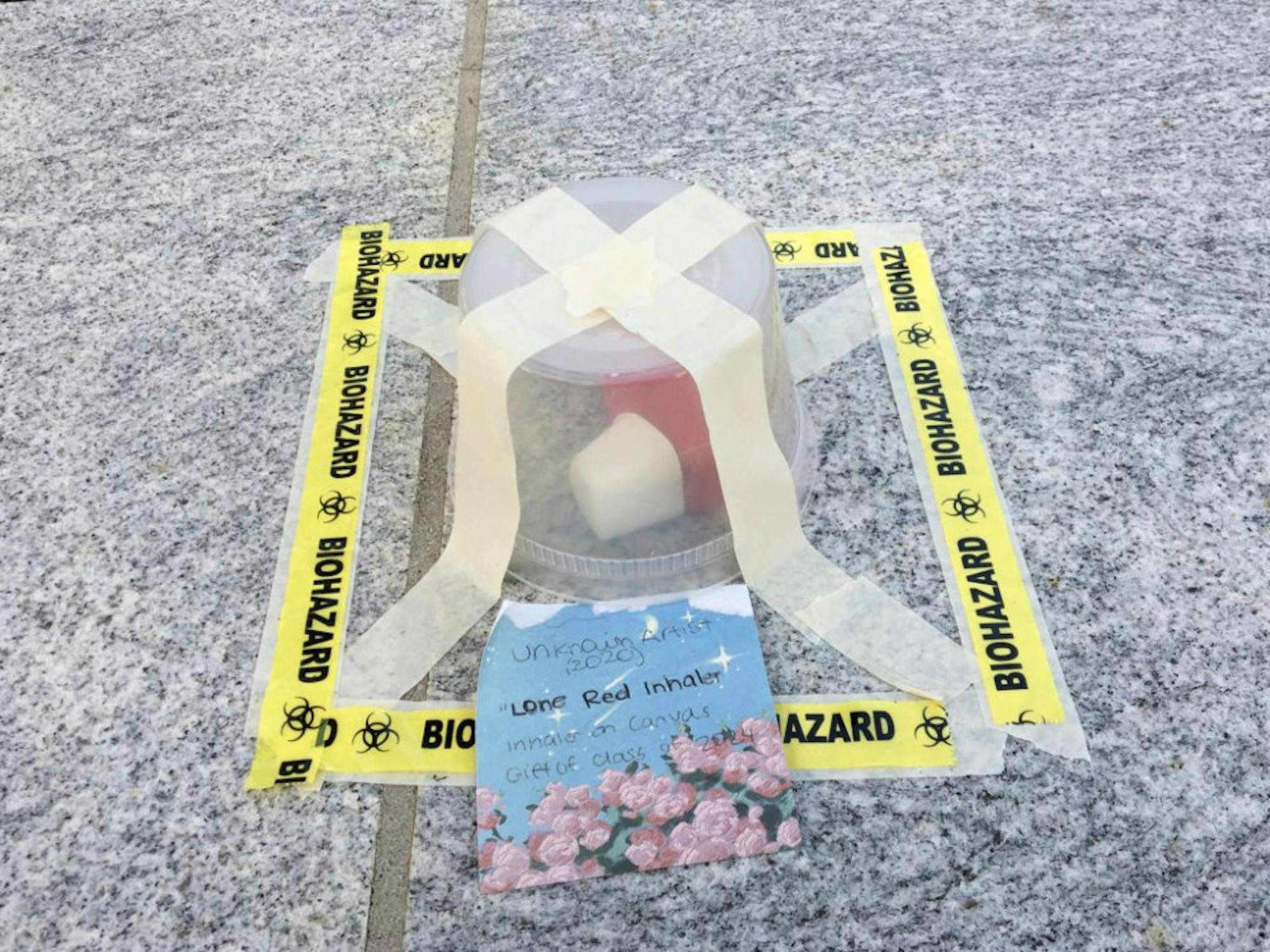I would typically associate an inhaler with the words “asthma,” “health” or “medicine.” Rarely would I expect an inhaler to be seen as art. However, Emory students looking for some light-hearted humor and a way to meet their first-year colleagues were willing to cross these boundaries. We’ve seen the myriad ways people try to connect with each other these days, whether it be virtual dances, Netflix watch parties, socially-distanced picnics or simply FaceTiming. A few creative students on campus this semester connected over an impromptu art exhibit featuring — you guessed it — an inhaler.
This inhaler art exhibit began as a joke in a GroupMe chat named “real eagles ONLY,” an informal student-created group chat full of chaos, memes and 888 first-year students. On Sept. 5, a picture of a lone red inhaler abandoned on a ledge near the Emory Student Center was sent to the group chat by Damisi Akinpelu (24C) with the caption, “If this is your inhaler… it’s sitting on the ledge near the DCT tables (near Asbury circle).”
Nobody knew who the inhaler belonged to, and nobody claimed it, but quickly the inhaler became an inside joke in the group. On-campus students clearly have not had many opportunities to develop connections and bond over humor, so this lost inhaler became the focus of dad jokes, conspiracy theories and puns. The jokes started out small.
“That photo took my breath away,” wrote Rebecca Schwartz (24C).
“The inhaler was planted to test the honesty of Emory students,” theorized Izzy Patton (24C).
Days went by, and photos of this lone red inhaler continued to circulate. The student body’s response and connection to the inhaler grew exponentially.
“The inhaler is the campus cryptid,” noted Anna Giglio (22Ox).
Before long, the inhaler became more than a joke. The inhaler eventually got its own “protective museum case,” which, due to the limited budgets of college students, was a clear bucket loosely taped over it. The inhaler was now an artistic mascot, a point of connection for Emory students, whether on or off campus. The status of this inhaler had reached that of “high art,” collectively esteemed by the Emory Class of 2024, requiring a museum-style label.
“Please make a sign that says something like ‘lone red inhaler/2020/artist unknown,’” Alison Barlow (24C) said.
Layla Dhabaan (24C), who had no outside interaction with Barlow, took immediate action on what she thought was a “great idea.” She grabbed a sticky note and labeled the inhaler with: “Unknown Artist (2020), ‘Lone Red Inhaler,’ Inhaler on canvas, Gift of Class of 2024.”

“To whoever did this: thank you,” Barlow wrote in response. Immediate gratitude and humor have formed these virtual bonds, without requiring anything more than a lost inhaler and a sticky note. To this day Barlow still has not met the writer of the label.
Dhabaan was similarly excited about the opportunity for collective bonding as a diverse freshmen class.
“Anyone could contribute to the masterpiece … I’m excited to see the future contributions made by our ‘artists’ on campus,” she wrote in the group chat.
The elevation in artistic status of the inhaler was the catalyst for even more theories, jokes and connections. Jordan Leslie (24C) suggested a petition be written for the inhaler to receive its “own exhibit in the Carlos Museum.”
Then, an unknown student printed a sign that read, “Emory Student Center Pop-Up Art Exhibit, This Year’s Theme: 6 Feet from the ‘Rona,’” and placed it with a tip cup next to the inhaler art. The Emory student community had masterfully formed a full-fledged, impromptu art exhibit for the general public.
Like any iconic artwork of popular culture, this public creation and obsession would not be complete without a proper conspiracy theory.
“The CIA planted the inhaler as a psychological experiment, and the nuclear launch codes are in there,” suggested Ron Berglund (24C).
While the nuclear launch codes may or may not be hidden in this inhaler art, we know for sure that this lost object became a wider cultural phenomenon and bonding experience for first-years on Emory’s campus this semester. Unfortunately, the inhaler art has since been removed, but the memories of this fluxus and community-driven art will forever be an influential part of the Class of 2024’s first-semester experience.





